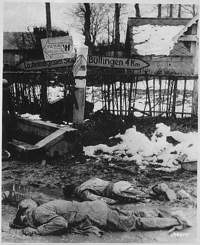Losheim Gap
| Losheim Gap | |||||||
|---|---|---|---|---|---|---|---|
| Part of Battle of the Bulge | |||||||
 American dead at a crossroads in Honsfeld, Belgium, at the northern end of the Losheim Gap |
|||||||
|
|||||||
| Belligerents | |||||||
|
|
|
||||||
| Commanders and leaders | |||||||
|
|
|
||||||
| Strength | |||||||
| U.S. 106th Infantry Division (elements of), 14th Cavalry Group (elements of) Total strength: 5,000 men, 20 light tanks, 12 medium tanks |
1st SS Panzer Division, 2nd SS Panzer Division Total strength: 25,000+ infantry, 200+ Panzers and SPGs |
||||||
| Casualties and losses | |||||||
| 450 killed 1,000+ wounded 2,300 captured 32 tanks |
200 killed 300 wounded 10-12 armored vehicles |
||||||
The Losheim Gap is a 5 miles (8.0 km) long, narrow valley at the western foot of the Schnee Eifel, on the border of Belgium and Germany. Most accounts of World War II describing the Battle of the Bulge focus on the attack by the Germans around the Siege of Bastogne and the Battle of St. Vith, while the Germans' primary ambitions were actually anchored in taking the Losheim Gap. In this region of the border between Belgium and Germany, it is the only region conducive to military movement.
In 1944, "Operation Wacht am Rhein" (Watch on the Rhine) was planned by Hitler to trade space for time by an attack which would advance through the Allied armies to Antwerp. This would be through "the Ardennes, a region that had long fascinated Hitler, where German armies had attacked with tremendous success in 1914 and again, at Hitler’s personal instigation, in 1940 .... (but not also, as is often erroneously remarked, in 1870. That advance was from the Saar-Palatinate through the Wissembourg Gap into Alsace)".
During 1940 when the Germans invaded Belgium and then France, Field Marshal Erwin Rommel’s division sped through the Losheim Gap to gain the Meuse River and then push onto the English Channel. Hitler held similar hopes for 1944.
On 15 September 1944 the U.S. 8th Infantry Regiment attached to 4th Division of V Corps was directed by division commander General Barton to advance from the border village of Schoenberg along the valley of the upper Our river. However, they didn't succeed because of multiple factors, hitting definite resistance first at the approaches to Losheim and later near the village of Roth.
During the Battle of the Bulge, some of the best German units, including the 3rd Fallschirmjaeger Division and Sixth Panzer Army planned to assault northwest over the Losheim-Losheimergraben road and along the railroad tracks through the Losheim Gap in force towards the twin villages of Rocherath and Krinkelt but were held up by the broken railroad overpasses.
...
Wikipedia
